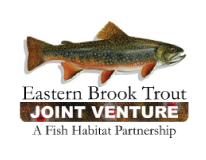Federal infrastructure funding
There is an influx of federal funding for infrastructure projects related to aquatic system health and fish passage. The funding under the Bipartisan Infrastructure Legislation is provided through many federal agencies; much of this funding increases the annual allocation for existing programs, and some of it creates new programs.
Interagency BIL Fish Passage Portal The portal is a “one-stop shop” for anyone who needs information, funding, or resources to improve fish passage and aquatic connectivity projects. We provide landowners and public lands managers the tools to find funding across the federal government, as well as access to data, planning, and geospatial information.
May 22, 2023
The Joint Committee on Fisheries Engineering and Science through the American Fisheries Society has put together two amazing tools for Aquatic Organism Passage (AOP) practitioners.
The first is a training portal listing guidance documents, courses, and handbooks for barrier removal and river restoration. The second is a series of organized checklists that provide guidelines for stepping through each phase of a fish passage project starting with feasibility through implementation. They’ve also included a glossary of terms for related to fish passage and stream restoration.
The website lists opportunities to provide feedback and suggest additional resources so please feel free to engage with the group if you have comments or suggestions. The Fish Passage Training Portal and the Checklists can be found on the Fish Passage Portal under the ‘Resources’ tab.
2022
The various partners involved in the legislation roll-out are working to fully implement the legislation. EBTJV, as part of the National Fish Habitat Partnership, was invited to participate in a USFWS fish passage workshop in July 2022 at the National Conservation Training Center. The workshop was the first step to developing a high-level strategic approach to BIL fish passage funding and implementation, and to creating a framework of coordination and stakeholder engagement that would constitute a new way of doing business.
Presentation files from FWS fish passage workshop (PDF)
Summary from FWS fish passage workshop (PDF)
This table lists aquatic infrastructure programs under the BIL, compiled by EBTJV. Information has changed and we encourage you to see the Interagency BIL portal above.
Program |
Lead Agency |
Total Funding Amount |
Eligible entities |
Priorities |
|
National Culvert Removal, Replacement and Restoration Grant Program
Link to notices of funding opportunity |
Dept of Transportation in consultation with NOAA and USFWS
culvertAOP@dot.gov
any openings and announcements here.
|
$1 Billion; authorized $800M by BIL and appropriated $200M every FY from 22-26 |
States, units of local government, or Indian Tribe
(projects can be on any roads as long as priorities are met) |
Prioritize awarding grants under the program to projects that improve fish passage for anadromous fish listed as federally Threatened & Endangered (T&E), at-risk, prey for T&E, climate resilient stocks; and projects that open more than 200 m of upstream habitat. |
| National Fish Passage Program |
USFWS
contact: Look here for regional offices to contact. |
$200 Million into an existing program ($40M annually over 5 yrs) in 2022, $38M was distributed across 23 states and 40 projects |
Federal agencies, states, tribes, municipalities, NGOs, private landowners Projects are selected regionally. Look here for regional offices to contact. |
Restoring fish and wildlife passage by removing in-stream barriers and providing technical assistance under the National Fish Passage Program |
| Forest Service Legacy Roads & Trails Remediation Program | USFS | $250 Million |
USFS roads, culverts and trails. prioritization will be coming from regions, with collaboration at regional level. use the following link to find a Forest Service contact. |
Restoring fish passages, road decommissioning, preparing roads for long-term storage, relocating NFS roads and converting NFS roads to trails, including improving resilience to extreme weather events, flooding, or other natural disasters. Prioritize projects that protect or improve water quality in public drinking water source areas, restore the habitat of a threatened, endangered, or sensitive fish or wildlife species, or maintain future access to the adjacent area for the public, contractors, permittees, or firefighters. |
| Collaborative-based, Aquatic-Focused, Landscape-Scale Restoration Program | USFS |
$80 Million over 5 yrs Funding already being put to work on the ground; 357 projects, over $100M, identified. |
Collaboratively-developed proposals on federal and non-federal land, including Tribal lands | 5 year projects to restore fish passage or water quality on federal and non-federal land. Gives priority to a project proposal that would result in the most miles of streams being restored for the lowest amount of Federal funding. |
|
Anadromous fish passage: Fish Passage ($65M) and Tribal Fish Passage ($12M) For more information click here |
NOAA
fish.passage.grants@noaa.gov infrastructure.tribal.@noaa.gov |
400M over 5 yrs. Fish passage: up to $65M /yr Federal funding requests: between $1 million and $15 million Tribal Fish Passage up to $12m with Federal funding requests between $300,000 and $5 million |
Federal agencies, states, tribes, municipalities, private landowners. | Restoring fish passage by removing in-stream barriers and providing technical assistance. |
| Pacific Coastal Salmon Recovery | NOAA | $172 Million | competitive grants to states and tribes | Restoring habitat for Pacific Coastal Salmon Recovery |
|
NOAA Contact Resilience.Grants@noaa.gov |
$85M NOAA will accept proposals between $1 million and $15 million total over the award period. |
This funding will prioritize habitat restoration actions that rebuild productive and sustainable fisheries, contribute to the recovery and conservation of threatened and endangered species, use natural infrastructure to reduce damage from flooding and storms, promote resilient ecosystems and communities, and yield socioeconomic benefits. | ||
|
NOAA Contact |
Up to $10 M projects between $75,000 to $1 million total over the award period.
|
Capacity building activities, including participation in municipal or regional-scale resilience planning, project planning and feasibility studies, stakeholder engagement, and proposal development for future funding.
|
||
| National Estuary Program | EPA |
$132M This funding will be evenly distributed among the NEPs, providing ~ $900,000 in BIL funds annually to each program. |
not an open funding program. EPA working with partners.
|
Authorizes transfer of funds for National Estuary Program grants,for the costs of carrying out their responsibilities under section 7 of the ESA. additional priorities see here |
|
EBTJV areas include: Basin ($40M) Chesapeake Bay (238 M) Long Island Sound (106M) Southern New England Estuaries (15M) Great Lakes Restoration ($1B) |
EPA |
$1.717B new grant streams added on top of existing funding programs |
State, local government, Indian Tribes, NGOs. Federal share for grants to state or local government is not more than 80% of project cost | Grants (process to be determined) to support infrastructure (which could be nature-based, green infrastructure, stormwater, WWTPs, etc.), environmental justice, and climate change. |
|
Colorado River Basin |
DOI (?) | $500 Million | State, local government, Indian Tribes, NGOs within Colorado River basin. | $100 M for watershed management projects; $250M for aquatic ecosystem restoration and protection; $100M for multi-benefit projects to improve watershed health; $50M for endangered species recovery and conservation programs - all within the Colorado Basin |
|
Klamath River Basin |
USFWS | $162 Million | State, local government, Indian Tribes, NGOs within the Klamath River basin | Klamath basin restoration activities including habitat restoration, planning, design, engineering, , environmental compliance, fee acquisition, infrastructure development, construction, operations and maintenance, improvements, and expansion, as necessary, on lands currently leased by the U.S. Fish and Wildlife Service for conservation and recovery of endangered species; |
| USFWS |
$26 Million (5.2m/yr infusion into an existing program that already has a grantmaking component with NFWF) |
State, local government, Indian Tribes, NGOs within the Delaware River basin | Supports investments in critical on-the-ground projects in the Delaware River Watershed aimed at conserving the region’s natural resources, restoring and protecting important habitat for birds and other wildlife, and helping ensure clean drinking water for more than 13.3 million people. | |
|
Invasive Species eradication at point of entry |
USFS | $100 Million | Federal and non-federal lands | $100 million for FS to detect, prevent, and eradicate invasive species at points of entry and grants for eradication of invasive species on non-federal land and on federal land |
| Abandoned Mineland Restoration |
USDA and DOI |
$200 Million | Federal and non-federal lands thru Secretary of Agriculture ($100M) and Secretary of Interior ($100 Million) |
To restore native vegetation and mitigate environmental hazards on mine lands |
| Abandoned Mineland Reclamation | Office of Surface Mining Reclamation and Enforcement (OSMRE) | 11.3 Billion | states and Tribes | In addition to the extension of abandoned mine land (AML) fee collections and mandatory AML Grant distributions, $11.293 billion in new funding was authorized to be appropriated for deposit into the Abandoned Mine Reclamation Fund. |
| Legacy pollution | DOI | $4.7B | states and Tribes | $4.3 billion to be used to plug orphan wells on state and private lands. $250 million to cap orphan wells on public lands, including in national parks, national forests, and wildlife refuges. $150 million to cap orphan wells on Tribal lands. |
| Dam safety | FEMA | $733 Milllion | states | Funding to FEMA to states under National Dam Safety Program Act to enhance dam safety and rehabilitate or remove aging dam |
|
|
|
|||
|
Forest Service dam decommissioning removal |
USFS | $10 Million over 5 years |
Non-hydropower Federal dams on USFS managed lands
smaller number of projects, sounds like (many?) have been identified prioritization will be coming from regions, with collaboration at regional level. |
Removal of non-hydropower Federal dams and for providing dam removal technical assistance |
| Dam safety, flood risk reduction, fish passage/water quality | Dept. of Energy |
Dam owners or operators of hydroelectric facilities RFI is open until 9/6/22 |
Incentive payments to dam owners or operators of hydroelectric facilities for improvements. , incentive payments max 30% | |
| Aquatic Ecosystem Restoration | ACOE | $1.9 Billion, incl. $1B for aquatic ecosystem restoration | Multi-purpose projects or multi-purpose programs that include aquatic ecosystem restoration as a purpose | |
| Joint Chiefs Landscape Restoration Partnership Program |
NRCS and USFS |
$180 Million (funding for FY22 and FY23 only; FY22 was due Aug 5). |
States, counties, muncipalities, federal agencies, tribes, NGOs collaborating with FS, NRCS and private producers program contacts below, or use the following links to find a local NRCS office or Forest Service contact | Through the Joint Chiefs’ Landscape Restoration Partnership, the two USDA agencies are restoring landscapes, reducing wildfire threats to communities and landowners, protecting water quality and enhancing fish and wildlife habitat. |
Document Actions





